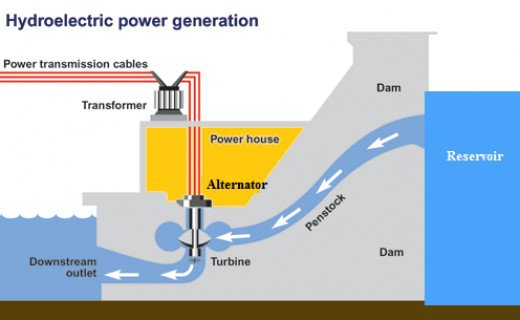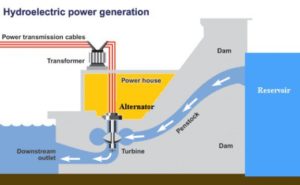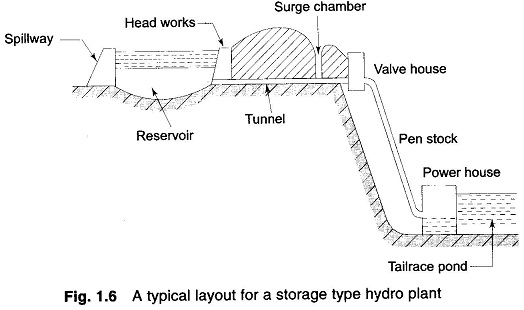Classification of Hydro-electric power plant
In this article we will know about the classification of hydro-electric plants. We will know about various types of hydro electric plant.
Classification of Hydro-electric power plant
The classification of hydro-electric plant can be classified According to various steps
Hydro plants can be classified, according to the extent of water regulation available, into following types:
According to flow of water , the classification of hydroelectric plant given below .
1. Run of river plant without poundage.
2. Run off river with poundage
1. Run of River plant Without poundage
These plants are located such that they use water as it comes, without any poundage or storage. There is no control on flow of water. During period of high flows or low loads, water is wasted. During lean flow periods, the plant capacity is very low. High flows or low. As such these plants have very little firm capacity. In such sites, the water is mainly used for irrigation or navigation and power plant is only incidental. Such plants can be built at a considerably low cost but the head available and the amount of power generation are generally low. Their principal aim is to use whatever high flows, these plants can supply a substantial portion of base load. flow is available of energy generation and thus save coal that would otherwise be necessary for the steam plants. During the period of The generation capacity to be installed for such plants requires a careful consideration. The 72 MW plants of Louisville Gas and Elect. Company on Ohio River in U.S.A. is an example of this type of plant. it is main types of hydro-electric power plants.
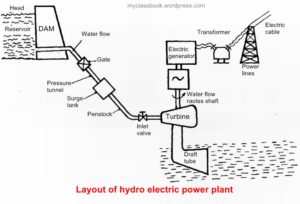
2. Run off river plants with poundage.
Poundage refers to storage at the plant to take care of hour to hour fluctuations in load on the station. Poundage increases the firm capacity of the station provided the floods do not raise the tail race water level thus reducing the effective water head and plant output. Such plants can serve as base load or peak load plants depending on the stream flow. When plenty of water is available, these plants can be used as base load plants. When stream flow decreases, these plants can be made to work as peak load plants. Show these two operated in operation of such plants. Thus these plants offer maximum conservation of coal when operated in conjunction with steam plants the 252 MW Hydro Plant and Safe Harbor Plant in U.S. A are example of this type of plants.
3. Reservoir plants.
Most of the hydro-electric plants, everywhere in the world, belong to this category. When water is stored in a big reservoir behind a dam, it is possible to control the flow of water and use it most effectively. Storage increases the firm capacity of the plant. The plant can be used as a base load plant or as a peak load plant depending on the water stored in the reservoir, the rate of inflow and the system load. Grand Coulee of reservoir plants. In U S A, KRASNOYARKS plant in USSR and BHAKRA plant in India are notable examples of reservoir plants.. it is basic classification of hydro-electric power plants.
2. Classification of According to load
According to load, hydro plants can be classified as base load plants, peak load plants and pumped storage plant.
(1) Base load plants.
They feed the base load of the system. Thus they supply almost constant load throughout and operate on a high load factor. Base load plants are usually of large capacity. Run off river plants without poundage and reservoir plants are used as base load plants. For a plant to be used as base load plant, the unit cost of energy generated by the plant should be low.
it is also main types of hydro-electric plant.
(2) Peak load plants.
They are meant to supply the peak load of the system. Run off river of plants with poundage can be used as peak load plants during lean flow periods. Reservoir plants can, of course, be used as peak load plants also. Peak load plants have large seasonal storage. They store water during off-peak periods and are run during peak load periods. They operate at a low load factor. A special type of peak load plant is pumped storage plant.
(3) Pumped storage plant.
It is special type of plant meant to supply peak load.
3. Classification of electric plant According to Head
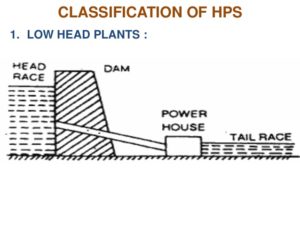
(1) Low head plants.
When head is less than 30 m, the plant is called a low plant. A dam or barrage across the river creates the necessary head. The power plant is located near the dam. And, therefore, no surge tank is need. Either one half of the barrage has regulating gates for discharge of surplus water while the plant is in front of the second half or the plant is constructed by the side of the river. Francis or Kaplan turbines are used. it is main types of hydro-electric plant
(2) Medium head plants.
The plants operating at head between 30 and 100 m. An open channel brings water from main reservoir to the fore-day from where pen stocks carry water to the turbines. Francis or Kaplan turbines are used.
(3) High head plants.
The plants operating at heads above 100m are generally classified as high head plants. The civil works for these plants include reservoir, tunnel, surge tank and penstock. Generally Francis are used for heads below 200m and penstock turbines for turbines for still higher heads.
If you will find any incorrect in above article you must comment below in comment box.
